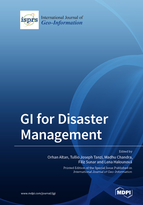GI for Disaster Management
A special issue of ISPRS International Journal of Geo-Information (ISSN 2220-9964).
Deadline for manuscript submissions: closed (31 January 2020) | Viewed by 48486
Special Issue Editors
Interests: photogrammetry and remote sensing; geographic information system; hazard and risk management; 3S technology in SDGs
Special Issues, Collections and Topics in MDPI journals
Interests: signal and image processing; disaster management; embedded systems; radar; drone
Interests: radar remote sensing; wave propagation; radar scattering
Interests: remote sensing; digital image processing; change detection; environmental monitoring
Special Issue Information
Dear Colleagues,
This Special Issue will present the potential of geospatial technologies in mitigating disasters like earthquakes, tsunamis, floods and landslides, which will be common occurrences in the future. The reduction of vulnerability through the adaptation of new and modern tools of GI technologies, e.g., through urban planning and construction, based on risk and vulnerability maps, as well as the quality and coordination of disaster mapping activities to support response measures are examples of topics with expected scientific results. The Special Issue will show how to coordinate efforts globally, as nowadays most disasters cross borders. Authors should present works in which geoinformation technologies are shown to help in all facets of disaster management.
Papers based on presentations from the upcoming GI4DM conference in September, 2019, will demonstrate the latest international advances in geoinformation for disaster management.
NOTE: This Special Issue is organized in conjunction with the upcoming GI4DM conference 2019 (http://www.gi4dm2019.org/), which will be held from 3-6 September 2019 in Prague, Czech Republic. It is open just for papers from GI4DM conference 2019.
Prof. Dr. Orhan Altan
Prof. Dr. Tullio Joseph Tanzi
Prof. Dr. Madhu Chandra
Prof. Dr. Filiz Sunar
Assoc. Prof. Dr. Lena Halounová
Guest Editors
Manuscript Submission Information
Manuscripts should be submitted online at www.mdpi.com by registering and logging in to this website. Once you are registered, click here to go to the submission form. Manuscripts can be submitted until the deadline. All submissions that pass pre-check are peer-reviewed. Accepted papers will be published continuously in the journal (as soon as accepted) and will be listed together on the special issue website. Research articles, review articles as well as short communications are invited. For planned papers, a title and short abstract (about 100 words) can be sent to the Editorial Office for announcement on this website.
Submitted manuscripts should not have been published previously, nor be under consideration for publication elsewhere (except conference proceedings papers). All manuscripts are thoroughly refereed through a single-blind peer-review process. A guide for authors and other relevant information for submission of manuscripts is available on the Instructions for Authors page. ISPRS International Journal of Geo-Information is an international peer-reviewed open access monthly journal published by MDPI.
Please visit the Instructions for Authors page before submitting a manuscript. The Article Processing Charge (APC) for publication in this open access journal is 1700 CHF (Swiss Francs). Submitted papers should be well formatted and use good English. Authors may use MDPI's English editing service prior to publication or during author revisions.
Keywords
- disaster
- earthquake
- tsunami
- flood
- landslide
- mitigation
- forest fire
- volcano







